Carl Zeiss Jena Schartenfernrohr Modell 96Wie das Schartenfernrohr Modell 94 wurde das Modell 96 auf der Festung "Kaiser Wilhelm II" und anderen in Panzer-Beobachtungsständen (PBSt.) als monokulares Fernrohr eingesetzt. Von den PBSt wurden wohl 14 gebaut, so dass sich auch hier die Gesamtproduktion des Schartenfernrohrs eher bei 2 Stück (Erststück und Ersatzstück) pro Turm plus einige zusätzliche bewegt. Die höchste bekannte Seriennummer ist 32 (Fernrohr mit Trägermontage im Dreiecklandmuseum Heitersheim). Das Fernrohr hat einen Okularrevolver mit zwei Vergrößerungen, nämlich 10x und 24x und ein 45mm Objektiv. Das Fernrohr hat am vorderen Ende des Objektivtubuses eine Ringwulst mit zwei runden Vertiefungen für die Montage und hinten eine Montageansatz unten mit einer Art Klammer, in die eine Kugelkopf griff, der mit einer Stellschraube (nach unten zeigend) für die Höhenverstellung zuständig war (s.a. Fotos mit Montage u. letztes Foto). Auf dem Montageträger (s. Fotos vom Museumsexemplar) ließ sich das Fernrohr vertikal und horizontal in der Scharte schwenken. |
Carl Zeiss Jena Embrasure Telescope Model 96Like the "Embrasure Telescope Model 94" the model 96 was used as a monocular in the Fortress "Kaiser Wilhelm II" and other fortresses installed in armoured observation stands. About 14 of the armoured observation stands were built so that again the total production number is about two telescopes per stand (first issue and a spare one) and some extra pieces. The highest known serial number is 32 (a telescope with its mounting rack in the Dreiecklandmuseum Heitersheim). The telescope comes wiht a eyepeice revolver with two magnifications, i.e. 10x and 24x. It has a 45mm obejctive lens. The monocular has a torus with two round pits at the end section of the objective tube which helps mounting the telescope; there is a moutning part, having a kind of a clamp at its bottom in which a ball head join in to steer the verical movement of the monocualr by turning a wheel (see also photos with mounting rack and last pciture). When mounted (see photo of the museum piece) the telescope could be tilted in both direction within the embrasure. |


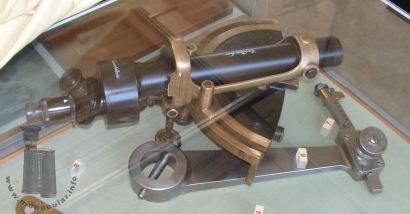
| Das Schartenfernrohr hat Beschriftungen an mehreren Stellen. Oben auf dem Tubus ist der Firmenname "Carl Zeiss Jena" in der damals üblichen verschnörkelten Schrift eingraviert, auf dem Okulardeckel des Prismengehäuses steht "Schartenfernrohr" sowie die Nummer als "No" mit der entsprechenden Modellseriennummer. Auf der Seite des runden Prismengehäuses (bei Montage oben) ist es mit "Fussartillerie" gekennzeichnet. Auch diese Beschriftungen sind mit einer verschnörkelten Schrift graviert. Ebenso trägt die Obejktifassung die abgekürzte Bezeichnung für das "Objektiv zum Schartenfernrohr" - "O. z. S.F. No" mit der identischen Seriennummer. Ein Dienstvorschrift zeigt, dass es zu dem Schartenfernrohr Mod. 96 auch ein "Vorratsobjektiv" (= "V.O.z.S.F.") gab. Die Okulare sind mit der Vergrößerung gekennzeichnet; das 10x Okular hat eine Dioptrienskala von + bis - 3 und einen Referenzstrich an der Okularhülse, während das 24x Okular eine umlaufende Dioptrienskala hat, die bei +/-5 markiert ist. Beide Okulare haben Hartgummiaugenmuscheln. | The embrasure telescope is marked in several spots. On top of the tube the maker's name "Carl Zeiss Jena" is inscribed in the floral script used at that time. On the top prism cover plate it says "Schartenfernrohr" (embrasure-Telescope) as well as "No" the corresponding serial number. The prism box side (being the top when mounted) is marked "Fussartillerie" (Artillery). These inscriptions are also engraved in a floral script. Furthermore, the objective frame is engraved with the abbreviated designation for the "objective for the embrasure telescope" (German: "Objektiv zum Schartenfernrohr") "O. z. S.F. No" with the identical serial number. A service regulation also mentions that the telescope came with a spare objective (German: "Vorratsobjektiv" = "V.O.z.S.F."). The eyepieces are marked with their power. The 10x eyepiece has a dioptre scale from + to - 3 and a reference line on the ocular tube, while the 24x eypeice has full dioptre scale being marked at +/-5. both eyepieces have an ebonite eyecup. |
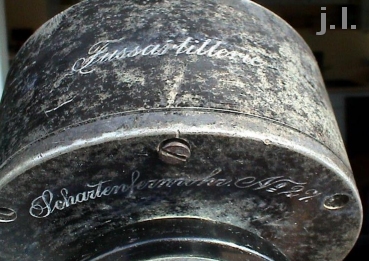
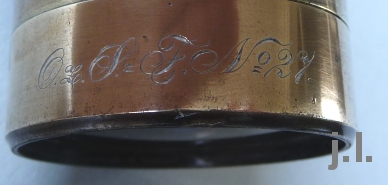

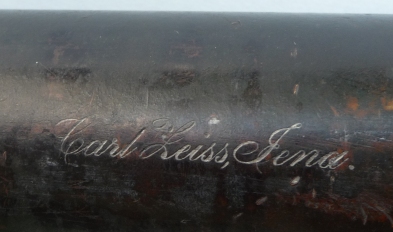
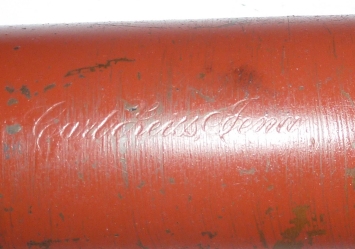
| Die Schartenfernrohre sind aus schwarz lackiertem Aluminium und Messing. Die vorliegende Nr. 30 wurde am Tubus rot lackiert bzw. mit einem Rostschutz grundiert. Das Prismengehäuse mit einem Porro-2-Prismensystem ist oben 6fach verschraubt, zum Tubus hin hat es einen konischen Ansatz. Der Okularrevolver schnappt(e) mit einem Federhebel in der entsprechenden Okularstellung ein. Das 10x Okular hat einen Justierring zum Drehen der Strichplatte. Diese hat fünf parallele Visierlinien, davon drei im engeren abstand in der Mitte. | The embrasure telescopes are made of black lacquered brass and aluminium. The model Nr. 30 was painted red on the tube or painted with a red anti-corrsoion primer. The prism box wiht its porro 2 prism system has six xrews on its top cover. There is a conical beginning part before the tube. The eyepiece revolver click-stops at the desired eyepiece position by means of a spring lever. The 10x eypeice has a adjsutment ring to rotate the reticle. The reticle has five sighting lines, three of them in the middle in a shorter distance to each other. |
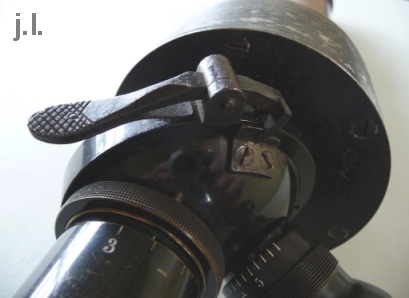
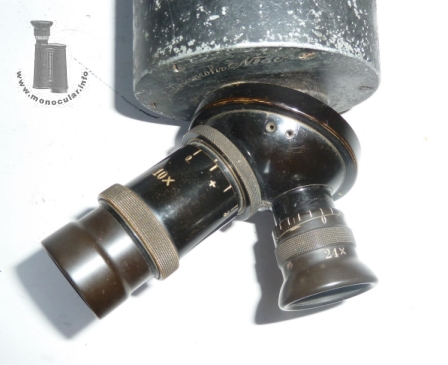
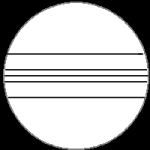
| Das Fernrohr wiegt 2407g (lt. Dreiecklandmuseum: 2500g). Der Fernrohrträger aus Bronze ca. 3kg. Beidess konnte in einer Transportkiste verstaut werden. Das Monokular ist je nach Okularstellung 49 oder 53 cm lang. Der 34cm lange Tubus ist 51mm im Durchmesser, das 48mm lange Prismengehäuse ist 100mm im Durchmesser. Der Okularrevolveransatz ist 43mm, der Okularrevolver selbst 74mm im Durchmesser. Das 24x 3/3 Okular ist 25mm, der Fokussierungsteil 31mm und die Augenmuschel außen 33mm; das 10x Okularstück ist 33mm, der Dioptrienteil 35mm, der Fokussierungsring 40mm und die 1/3 Augenmuschel 35mm im Durchmesser. | The telescope weighs 2407g (according to the Dreicklandmuseum it is 2500g). The bronze mounting rack weighs 3 kg. Both could be stored in a carrying case. The monocular is 49 or 53cm long depending on the eyepiece used. The 34cm long tube is 51mm in diameter, the 48mm long prism housing is 100mm in diameter. The eypiece revolver tube is 43mm, the eyepiece revolver itself is 74mm in diameter. The 24x 3/3 eyepiece is 25mm, the focusing ring 31mm, and the eyecup 33mm in diameter; the 10x eyepiece is 33mm, the dioptre ring 35mm, the focusing part 40mm, and the 1/3 eyecup 35mm in diameter. |
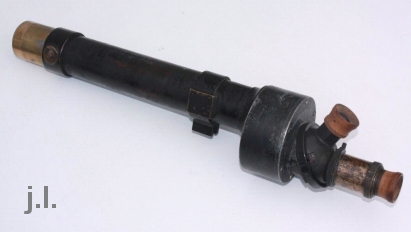
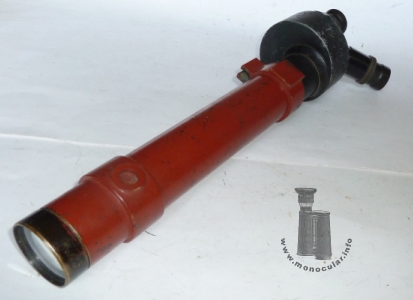
Fotos: Zeun, J.Laucher

